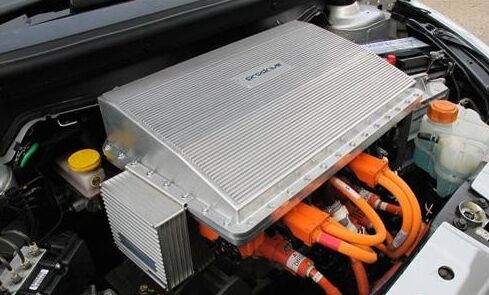
Recently, a cooperative alliance led by motor sports and technology company Prodrive announced the successful development of a silicon carbide-based multi-port DC-DC converter for electric vehicles. The SiC multi-port DC-DC converter can control a variety of energy sources, so its efficiency can reach 98.7%. At the same time, the above silicon carbide multi-port DC-DC converter can not only increase the energy density, but also reduce the size and weight of the converter compared to a single-silicon based converter system.
This article refers to the address: http://
The most important point of this SiC multi-port DC-DC converter is that it uses silicon carbide as its basic material. Silicon carbide materials operate at a higher frequency than single silicon materials. The test frequency of the silicon carbide multi-port DC-DC converter used in the test vehicle can reach 75000 Hz, and the energy conversion loss of the system can be greatly reduced by increasing the rated operating frequency of the energy converter. In addition, by using silicon carbide materials, the size of the magnetic components in the energy converter can be greatly reduced, so that the efficiency of the converter can reach 98.7%. The above multi-port DC-DC converter using silicon carbide material can have a weight power density of 10.5 kW/kg and a volumetric power density of 20 kW/liter.
The silicon carbide material energy converter can withstand higher operating temperatures than conventional material energy converters. In this way, the silicon carbide material energy converter can be integrated into the power electronics and even integrated into the cooling system of the internal combustion engine system of the hybrid system.
The DC-DC energy converter acts as an energy transmission hub for vehicle high voltage electrical systems. It consists of four ports: two of which are connected to the traction motor and the high-voltage battery; the third port is connected to the auxiliary backup power supply. In this test car, the third port is connected to the vehicle's supercapacitor. Group; the last fourth port is connected to the vehicle's 12 volt drive system.
The DC-DC energy converter can receive and respond to commands from an external monitoring controller, the Controller Area Network (CAN), which can also match different voltage values ​​of different systems and transfer energy between each other.
The test vehicle used Tata Motors' Vista EV, which was developed by the Warwick Tata Motors European Technical Centre, which uses a 220 volt battery. And 37 kW traction motor. In addition, the above Vista electric vehicle test vehicle is also equipped with two 200 kJ supercapacitor banks with a voltage operating range of 75 volts to 150 volts.
Mark Willows, an electrical system and control expert from Prodrive, said: "In people's daily driving, the energy converter can increase the battery voltage to about 400 volts to optimize the performance of the motor. At the same time, if necessary, energy conversion during vehicle driving The device can also draw additional energy from the supercapacitor bank, while in the energy recovery phase, the energy converter can recover the energy of the vehicle into a battery or supercapacitor bank when it is commanded by an external controller. The converter also enables direct energy transfer between the battery and the supercapacitor port. The energy converter system can be matched to other energy sources via an adapter. For example, the energy converter can be matched not only to the fuel cell but also to multiple towings. The motor performs matching transmission energy."
There is news that the Prodrive Cooperative Technology Alliance is in the process of a follow-up project. The project focuses on improving the operating voltage of the energy converter to 750 volts. This will further increase the working energy density and increase the maximum operating temperature of the system.
Mark Willows said: "For the follow-up projects of the above energy converters, we have developed a rolling test stand based on a light commercial vehicle chassis. The above light commercial vehicle chassis uses a 75 kW traction motor, and its energy storage device includes a 320 volt. Lithium-ion battery and two supercapacitor groups, all of which were designed by Prodrive for the above projects."
The cooperative technology alliance led by Prodrive was strongly supported by the Technical Strategy Committee. In addition, the project also includes the University of Manchester, Tata Motors Europe Technology Center, IST Power Products, Raytheon Systems and SCISYS.
Since the development of the four-wheel-drive hybrid hybrid prototype in 2001, Prodrive has had more than a decade of experience in project development for hybrid and pure electric vehicles. Prodrive is involved in a number of research and development related to hybrid and pure electric vehicles, including the development of new energy prototypes for motorcycles, commuters, buses and trucks, research and development of similar power technologies, and research and development of various power technologies. . Among them, a variety of power technologies mainly involve hybrid batteries, super capacitors, fuel cells, and high-speed motors.
Our company is specialized in supplying Refrigerator Compressor.Refrigerator Compressor is wildly used in household refrigerator, freezer, water dispenser, wine cellar, commercial refrigeration showcase and other small cooling appliances for home, car, ship and camping. We have multiple models of compressors with different refrigerant (r134a,r404a,r600a,r290) for different applications.We could provide you compressor both from those famous brand and OEM factory. We promise our customer a good quality and well organized after-sales service to let our customer have faith in us.
Refrigerator Compressor
Refrigerator Compressor,Fridge Compressor,Refrigerator Compressor Cost,Mini Fridge Compressor
ZHEJIANG ICE LOONG ENVIRONMENTAL SCI-TECH CO.,LTD. , https://www.china-refrigerantgas.com